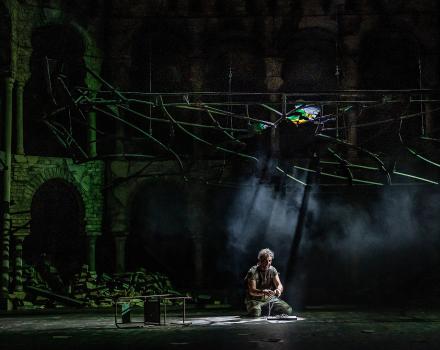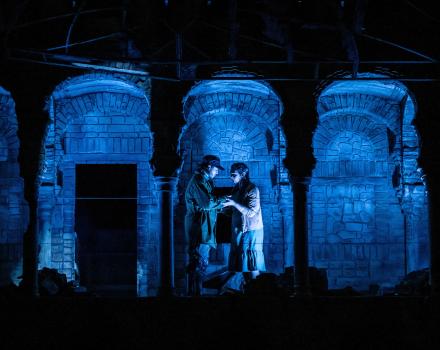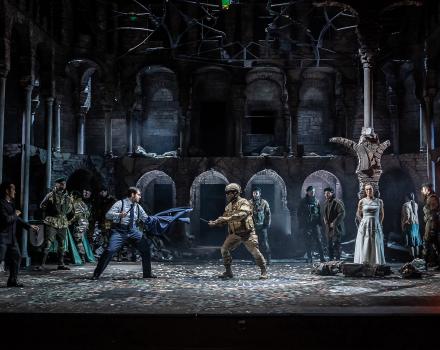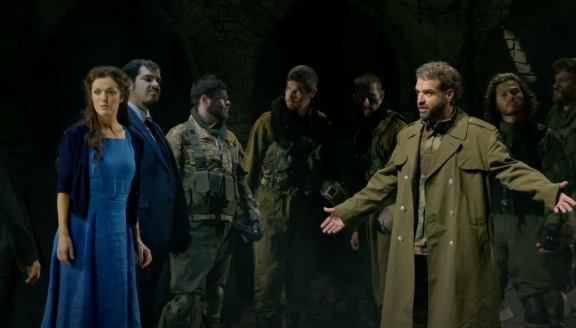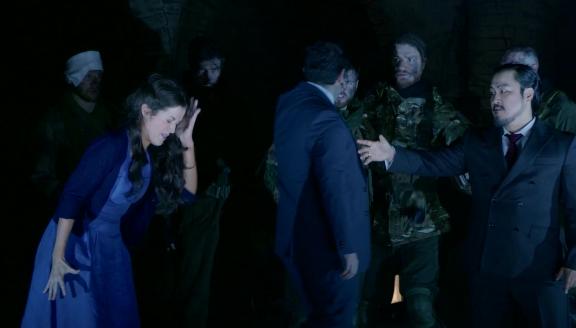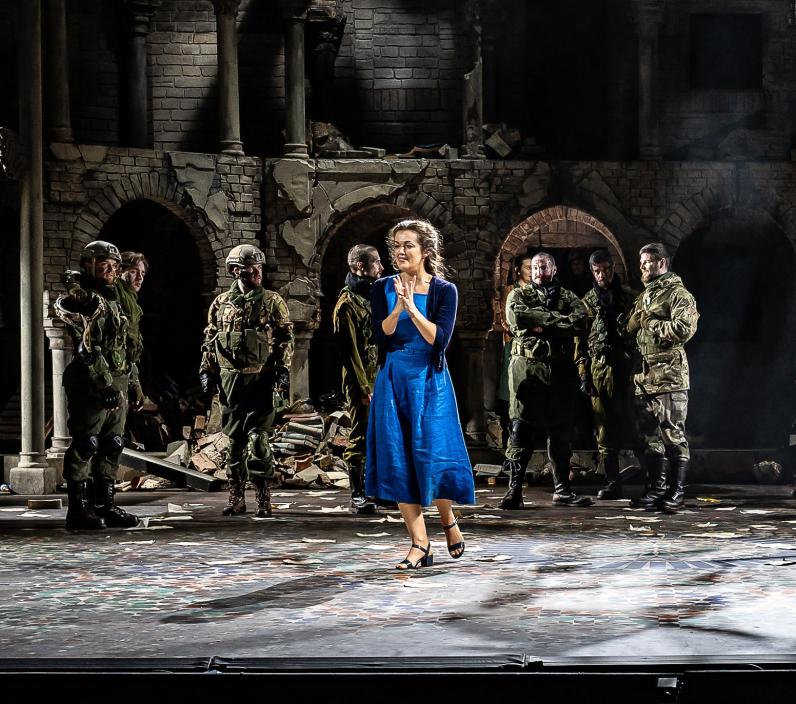
Zoraida di Granata

The action takes place during a Spanish attack on the Moorish capital of Grenada, where Almuzir has deposed and killed the legitimate King and usurped his throne. Almuzir is in love with Zoraida, but she is already betrothed to general Abenamet. Machinations ensue and, though Almuzir tries to dispose of Abenamet, the general outwits the ruler by disguising himself as an unknown knight. Will Abenamet finally win the day and the hand of his beloved Zoraida?
Any A-Z of Donizetti’s 70 or so operas must eventually come to Zoraida di Granata, but actually, it belongs much higher up the list: a very early work, it was his first big success. The composer was only 24 when Zoraida di Granata was premiered at Rome’s Teatro Argentina in January 1822, although the opera was nearly born under an unlucky star, since the tenor originally cast as Abenamet fell fatally ill during rehearsals. Only a handful of Donizetti’s operas hold a place in the mainstream repertoire, but our appreciation of them has been radically changed by a better acquaintance with some of the lesser-known titles. The music shows the composer, if still under the influence of his teacher Simone Mayr, absorbing the brilliance of Rossini. OperaVision is delighted to host its first stream from the 2023 Wexford Festival Opera, which has produced more works by Gaetano Donizetti than any other opera festival in the world, only topped by Donizetti Opera Festival (Bergamo, Italy). In particular, WFO is credited for the rediscovery of L’elisir d’amore, in 1952, which has subsequently found its way into the operatic canon. The production is conducted by Diego Ceretta and directed by Bruno Ravella, several of whose productions (notably from Garsington) have delighted OperaVision audiences.
Cast
Zoraida | Claudia Boyle |
|---|---|
Almuzir | Konu Kim |
Abenamet | Matteo Mezzaro |
Ines | Rachel Croash |
Almanzor | Julian Henao Gonzalez |
Ali Zegri | Matteo Guerzé |
Dancers | Luisa Baldinetti Miryam Tomé |
Orchestra | Wexford Festival Opera Orchestra |
Chorus | Wexford Festival Opera Chorus |
| ... | |
Music | Gaetano Donizetti |
|---|---|
Text | Bartolomeo Merelli |
Conductor | Diego Ceretta |
Director | Bruno Ravella |
Sets and costumes | Gary McCann |
Lighting | Daniele Naldi |
Assistant Director | Noemi Piccorossi |
Assistant Designer | Gloria Bolchini |
| ... | |
Videos
Story
Before the action starts, Almuzir has usurped the throne, killing the king of Granada and Zoraida’s father. He has placed Abenamet, head of the army and chief of the Abencerrages faction under house arrest.
ACT I
In a Granada square. The city is under siege. The king, Almuzir, reproaches the people who despair as the city, without its military leader, is about to fall under the blows of the Spanish army. He is not concerned with the city as the walls are strong, but with Abenamet, a political rival, and with Zoraida, his beloved. Almuzir also loves Zoraida. As the Spaniards renew their attack, he entrusts the command of the Arab army again to Abenamet himself, promising to marry him to Zoraida if he returns victorious. The King gives him the city standard, but emphasises that its loss incurs the penalty of death. When Abenamet returns to the palace victorious, but without the standard, having been tricked by Almuzir, he is convicted of high treason. Despite the pleas of Zoraida, Abenamet gets dragged away to prison awaiting a certain death.
ACT II
A subterranean dungeon. Abenamet is kept captive awaiting death. Almanzor, Abenamet’s friend, comes to free him and tells him to flee to save himself. Abenamet finds out Zoraida has agreed to marry Almuzir and he leaves in a fury to find her.
An orange grove. It's night. Zoraida alone laments her fate. Abenamet arrives, closely shadowed by Ali Zegri, Almuzir’s right hand man. He accuses Zoraida of having betrayed him, and pulls a gun to kill himself. Zoraida grabs the gun and explains this was the price paid to save his life. She professes her eternal love to Abenamet but the conversation is interrupted by Almuzir, who has heard everything. As Abenamet manages to escape, Zoraida is accused of treason and arrested.
A Granada square. Unless a warrior comes forward to defend Zoraida’s innocence, she will be burned at the stake. A brave knight shows up. He fights Ali and wins. It is Abenamet who forces Ali to confess his crime. Upon hearing the truth, the army turns on Almuzir to lynch him, but Abenamet defends the king. Moved by so much bravery and nobility, Almuzir renounces the hand of Zoraida in favour of Abenamet.
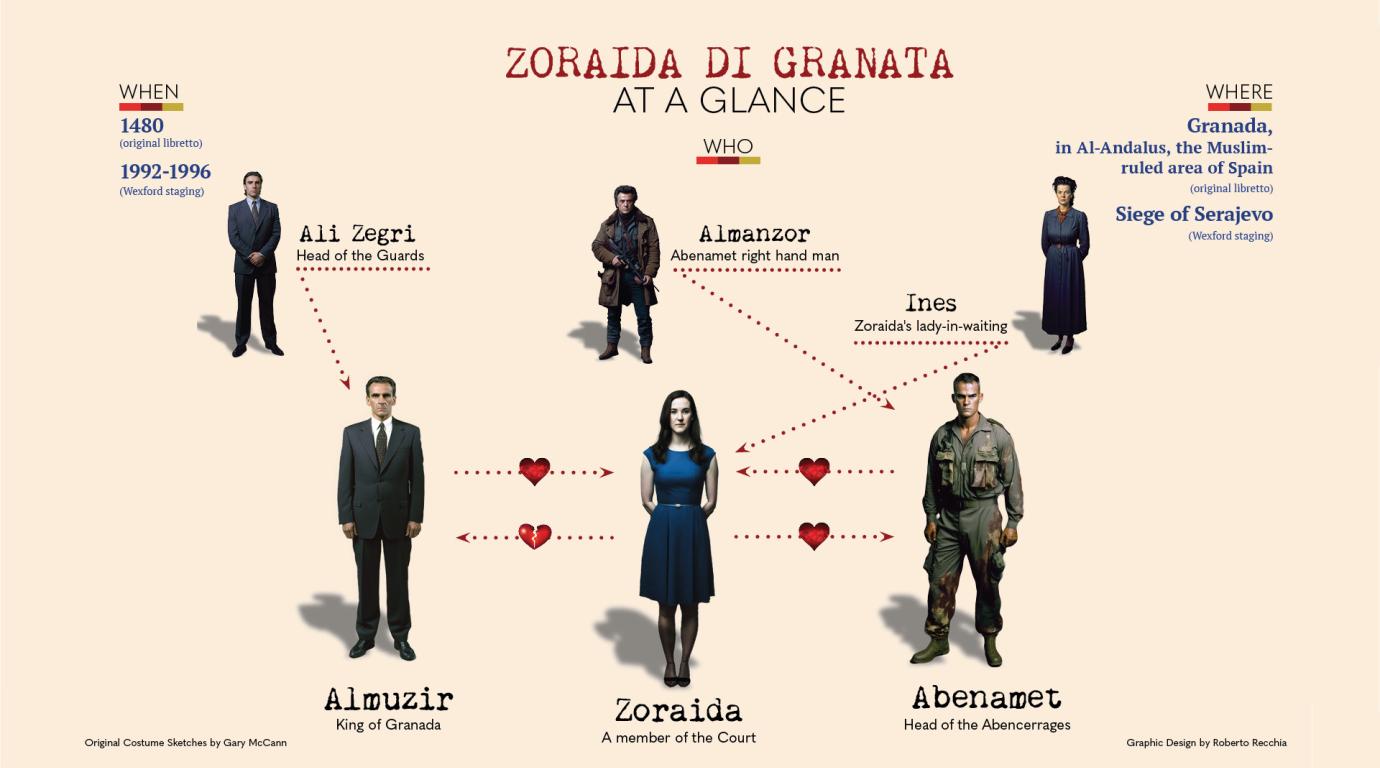
Insights
Sarajevo, mon amour
Director’s notes by Bruno Ravella
The suggestion of a production of Donizetti’s Zoraida di Granata came from Rosetta Cucchi, Artistic Director of Wexford Festival Opera. She mentioned it to me in the context of her Women & War theme, with the possibility of the collaboration of the Bergamo Donizetti Opera Festival. That collaboration would be in the production of the later version of the opera, of which two versions are extant. I was immediately intrigued by the possibilities.
Donizetti composed Zoraida when he was only 24 years old. The first version dates from 1822 and this is the version scheduled for Wexford. The second version is that of 1824 which is destined for Bergamo. In that version, new pieces have been added or substituted. Abenamet is no longer a tenor but a contralto. The setting, developed with the designer Gary McCann, needs to work for both versions. I was able to listen to this never performed opera thanks to a recording by Opera Rara. My first impression was that it was a combination of Act Two of Tosca and Act Two of Fidelio. There is a love triangle: the despotic ruler Almuzir is trying to force Zoraida into marrying him. She however is in love with Abenamet who is imprisoned in a city which is under siege and which is enveloped in civil war. The political aspect of this struck me most forcefully. Alzumir’s precarious position as a usurper with no military support means he needs Zoraida to bolster his position which is threatened both within and without the city. His love for her is contiguous to this position in which Abenamet is an enemy twice over, as a love rival and political threat. The mood is one of extreme paranoia and claustrophobia. I decided that the evocation of this was a way to approach the opera.
The opera is set in Granada in 1480, at the time the city was an Islamic polity. All the characters are Muslims, apart from Ines the Spanish slave, and even she may have converted to Islam. However, I was wary of the trap of orientalising the story as nowhere is there any evocation of Islam in the libretto or the music. I felt that for Donizetti and his librettist, the main elements of the story were more universal: a love story against a backdrop of civil war in a city also besieged from outside. I remembered the siege of Sarajevo 1992-1996. There we also saw the resilience of the human spirit under extreme conditions that seemed to parallel 1480s Granada: civil war, ethnic and religious persecution. Although those besieged in Sarajevo were also technically Muslims, their plight like those of Granada in 1480 was nothing to do with religion but with large political forces. Thus the Sarajevo setting with its evocative Islamic architecture seemed to make this analogy doubly appropriate. More specifically, a building soon provided the key piece: the National and University Library of Bosnia and Herzegovina. It was built in the late 19th century in the Moorish Revival style, and naturally connected the old with the new. This building was founded to provide comprehensive knowledge of the life and culture of the peoples of Bosnia and Herzegovina. Its destruction on 25 August 1992 during the siege had strong symbolism that still resonates today. The library, a repository of knowledge, becomes a symbol of both the resilience of culture and the tragedy of its destruction. Like this building, the battle ground in the opera is gradually reclaimed, symbolising the strength to rebuild and the hope for a better future.
And finally to the powerful theme of the season: Women & War. It raises many questions: whether war can be gendered, the role of women contextually and whether war shifts relations between the sexes. Do the huge variety of experiences and the extraordinary levels of traumatic events and previously unimaginable adventures bring about fundamental alterations in the male/female dichotomy? In Zoraida di Granata we have four male principals and the chorus is all male, even when it represents in the libretto the ‘people of Granata’. This makes our two female principals more prominent. It is through Zoraida and Ines that we explore the emotional and physical impact of the war.
They force us to evaluate their positions and draw us into their suffering. The picture is complex and I hope to do it justice in the way I have configured the opera. The womens’ lives are dramatically upturned by male greed, lust for power and love of conflict. Zoraida’s constancy, moral strength and integrity enable her to stay true to her principles. She is at the mercy of the events but not a victim: she is incredibly strong, prepared to stand her ground at all times and die for her beliefs. Through Ines, the horrors of the battlefield receive forceful expression. These two women challenge us to redefine what heroism is.
Gallery
